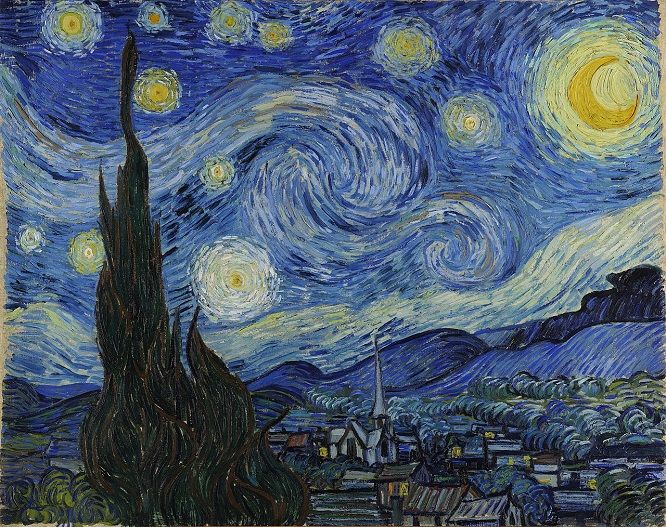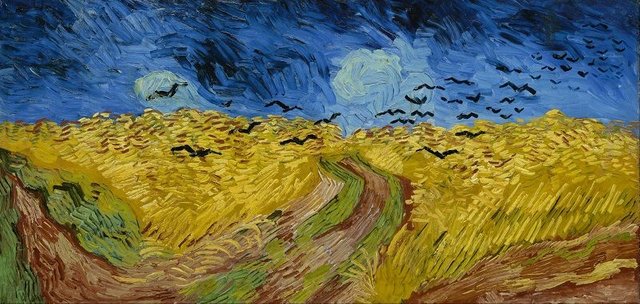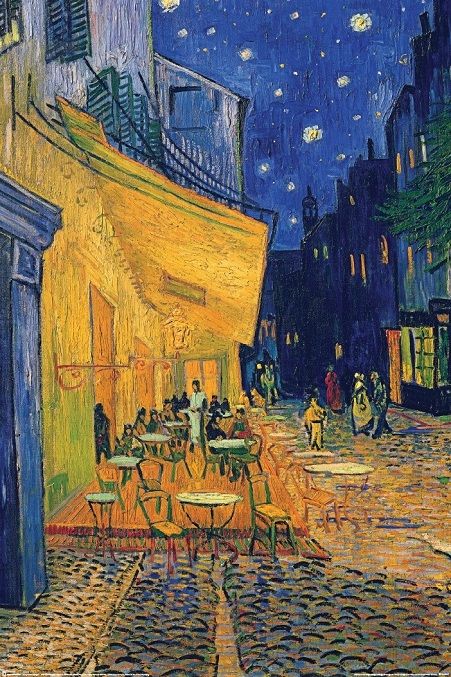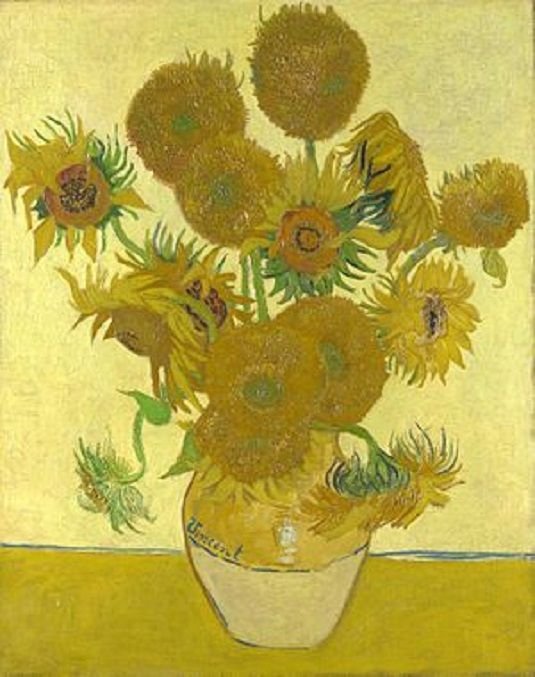The genuis Vincent Van Gogh
Vincent Van Gogh, as well as Rembrandt, is a Dutchman. This is the first external factor, mischief in biography, which is not always accidental and gives us the key to human life. Even Hippolyt Tenn and other sociologists have discovered the causal relationship between art and the surrounding environment. But here perhaps a small correction must be made - sometimes the connection between the human spirit and the environment has the opposite effect. There are brilliant artists whose work is a kind of reaction to a rebellion against the injustices of the time they live in. Similarly, Van Gogh's life and creativity is a kind of protest against the Dutch. From a small age he was a "strange man" against the backdrop of the "normal" life that surrounds him and he feels it. In 1886, Vincent moved to Paris and never returned to his homeland ..... Becoming a passionate supporter of the plexiglass, he traversed the streets of the city and feels like a true Frenchman. He becomes an ally of Impressionists and encourages their success.

"Starry Night" by Vincent van Gogh
But Van Gog's fiery nature is extraneous to the environment in which he lives. In everything he engages, he wants to bring it to the end. Seeking light and air, he leaves gray Paris and goes south. The first impression does not lie. Provence is wonderful and the only thing Van Gog is sorry about is that he didnчt come here in his youth. The technique of painting plays a much larger role than before. When we look at paintings of old masters, we forget about technique, manners - so balanced in their form and content. Modern man is so far away from all this, from this classical balance of mind, and that is why we first of all notice the artist's subjective approach to this or that object. There are realistic artists who, with such submissive passivity, accept the world that we just forget about their human personality that we just exclaim "It's painted like it's alive...." But there are other artists with an irresistible and rebellious soul who can not hide behind objects depicted. Looking at their paintings, we see not only the depiction of them, but we see beyond, we see the artist's feelings and experience in them. In such artists, the technique of individualism occupies a central place and at some point even ceases to be a technique in the sense of the word, but becomes a way of life. This is Van Gogh. He is indeed an impressionist in the deepest sense of the word, more impressionist than any other we are used to calling such, because he changes his technique sometimes. Each subject impresses in a different way, and each time it vibrates the strings of his soul differently, and his hand tries to record these inner notes. He uses a brush, then a knife, thin and dense paint, throws stains... He makes them guilty at first impression, as if in an ecstasy moment, as if the picture comes out from under his hand like a cry of enthusiasm for the majesty of nature and man's worthlessness . Vincent himself is forever unstoppable and vigorous, his world is in a ruthless circle. He perceives objects not as bodies, but as phenomena. This does not mean that he seals the flashing momentarily. He draws him in his dynamic development. He is an artist of world rhythms. He does not paint how the sun just sets, but how it sinks throwing its rays like a golden fog from the hills.

"Wheatfield With Crows Painting" by Vincent van Gogh
Van Gog's dynamic manner is even more noticeable in his paintings painted with a reed feather, drawing with Japanese virtuosity. There is no known contemporary who has such a certainty on the lines, such a strong suggestion. Tree running in the heights with curly lines forming spirals, grass growing vertically or turbulent here and there ... This is the portrait of the postman from Arles. The virtuosity colors in this painting are so virtually scattered. Van Gogh himself describes the postman happy and proud because he has just become a father. Even in the self-portraits of the artist, from behind the depicted faces, we are able to peer into the soul and its essence. The main thing in Van Gogh's work is the choice of colorful color. The power of color is its creativity. In a letter to his brother Theo, Vincent writes that he wants to portray a friend while dreaming a beautiful dream. He wants to invest in his portrait all his love for his boyfriend and chooses rather arbitrarily the paint. Exaggerating with gold for the color of his hair, he stains with the deepest blue background wall. This creates the illusion of a golden star on the blue sky. This is Van Gogh. In the same way he does it with a peasant portrait, imagining this man under the fiery sun at the height of the harvest. He painted the background with the color of fired iron. There is the difference between Van Gogh and all the other portraits who think that everything is exhausted. The colors in the background of Vincent are not a random decoration. One of his arches, probably a provincial splinter, is painted in blue-black like a wingspan, and thus more like a murmuring spider. Every color, viewed from Van Gogh's point of view, had its own laconic meaning. He not only loved multicolor, but it also gave him a secret sense. But of all the colors he was most enchanted by the blue and the yellow. The yellow range - from the delicate-lemon to the bell-orange - was a symbol of it, but the sun, rye, Christian love. That he loves the most. The blue range - from the sky - the blue to the raven - the black - was for him a symbol of the impassive eternity, the cool necessity, the night sky, the death. He himself gravitated to it, but he was also afraid.

"Cafe Terrace at Night" by Vincent van Gogh
Van Gogh says, "I prefer to draw people's eyes instead of cathedrals. The human soul, even the soul of an ungodly beggar or a poor boy, is much more interesting. Whoever describes the peasant's life will best endure the test of time. I will remain myself and even in the raw works I will speak strictly, roughly but only the truth. " Can a person who, in these and thousands of similar speeches, can explain the meaning of life and art, rely on success among the "strong of the day"? The bourgeois audience does not forgive innovation, and Van Gogh is an innovator, in the direct and transportable sense of this notion. His reading of the beautiful passes through extreme contradictions - ranging from tiny shoes to devastating cosmic ragans. At the beginning of the 20th century, opposed to Van Gogh's art, a new term emerges - "post-impressionism". In Impressionism this reaches the peak of its development, reflected in the amazing naturalness and diversity of artistic techniques. In the amazing diversity of nature, Impressionists have managed to capture her beautiful face and its endless renewal. Van Gogh offers a fundamentally innovative method, a method for synthesizing observations and knowledge, an analysis of the inner essence of things and phenomena, and all this expands the cognitive abilities of art. "I see everything in nature, for example in the trees - the soul." These words of Van Gogh are the key to his interpretation of the artistic image. At its core is the merger of two principles, one of which concerns the work with nature, and the second determines the creative impulse of the artist, allowing him to see reality in a much brighter and transformed form. Once Van Gogh compares the academic painting with a prodigious mistress who "frizes you, drinks your blood and turns your heart into a stone ... Send this mistress to hell and fall in love with your true love - Lady Nature or Reality" . This lady loved him all her life. No force was able to tear Van Gogh away from his art. But his love for Lady Reality was far from blind. In Van Gogh's eyes, working with nature was tantamount to "tame the shrewd" Each component of nature turns Van Gogh into a chamber of emotions and feelings. Nature gives him not only motives, but also becomes a moral support for him, a source of moral strength. Van Gogh's main creed is to be in love with mankind. He stands above the prejudices. Without thinking, he would turn his last shirt into a wound dressing for a wounded miner's wound, break up bread and shelter with both poor children and a prostitute. "There is nothing more artistic than to love children!"

"Sunflowers" by Vincent Van Gogh
Van Gog's aesthetics is the result of imagination from another world. His "wonderful" smell of the earth, the ripe grains, the farmer's labor, the wind, the winds spread. In everything he sees beauty. It takes beauty and the greatest grotesque. His see beauty as a woman. Questions about the life of nature would never have been resolved if Impressionists had not gone out into the street, in the nature, on the riverbank ... Vincent said, "I wish the beauty came not from the material, but from myself." Dreaming for a brotherhood of artists and collective work, he forgot that he was an irreversible individualist. But that was precisely his power. You need to have trained eyes to distinguish Monet's picture from that of Sisley. But once he saw Van Gogh's "Red Vines", one would never mistake Vincent Van Gogh for a picture. Each line and stroke are an expression of his soul. In the painting, in the manner of Van Gogh, everything is equal and merged into a perfect ensemble - rhythm, color, line, shape. As in the music there is a major and minor arrangement, the same way in Van Gogh's art, the palettes are divided into two poles - cold and warm. Like life and death. In Van Gogh's mind, the two colors - yellow and blue - have deep symbolism. In the yellow he sees the bright beginning - the sun, the ripe corn. For him it is the color of the light beginning, of love and life. And blue, from blue to almost lead gray, is a symbol of grief, grief, despair, and ultimately of death. In Van Gogh's life, life is the ability to think, feelings of affection. The paintings of Van Gogh - strokes thrown on the canvas with a quick hand. Like a "dash, dot, comma" - This is the basis of Vanghogov's art. Expressive without much explanation and detail. In every painting is the fight between man and nature. Beautiful and endless struggle. Color Fighting.

"Landscape at Auvers in the Rain" Vincent Van Gogh
It is often said that in Van Gogh's painting there is some unbridled, unmanageable emotional element. But that's what makes it so original. Van Gogh was extremely gifted in his work. This talent is at the expense of his personal life - mutilated physically and spiritually. He died at thirty-seven years. Van Gogh says "I paid my life for my art, but it took half my brain." His last picture provokes contradictory feelings. A mixture of despair, coldness, chill, but more often grief and touching pain. "Landscape at Auvers in the Rain" suggests peace and goodness, dictated precisely by the artist's state of art. The brightness of the green color, the horses harnessed in a wagon on the wet road. Smoke from the train running down the rail. All this would be almost idyllic if it was not the rhythm of strokes and colors, suggesting some vague tension. Just a moment, and all this world seems to blow out of some sort of shattering, unclear power. "Thousands of torment ... I'm in torture! But there I see the sun, and even when I do not see it - I know it is there. And knowing that there is the sun, I know it is life! " These Dostoevsky words could also be attributed to Van Gogh. Life is grief and suffering. And art always wants sacrifices.